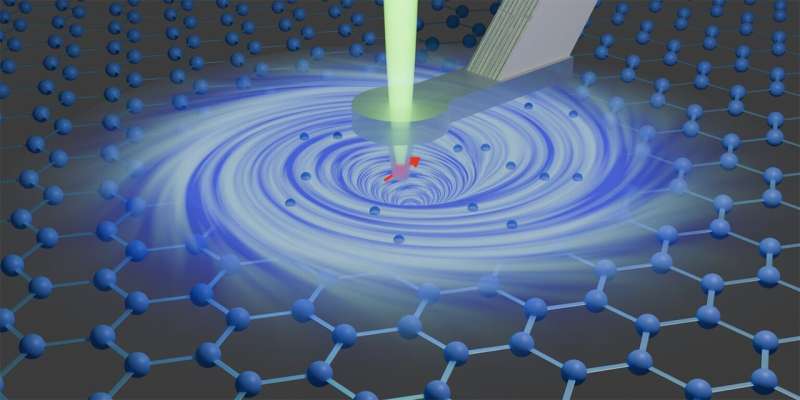This article has been reviewed according to Science X's editorial process and policies. Editors have highlighted the following attributes while ensuring the content's credibility:
fact-checked
peer-reviewed publication
trusted source
proofread
Electron vortices in graphene detected for the first time

When an ordinary electrical conductor—such as a metal wire—is connected to a battery, the electrons in the conductor are accelerated by the electric field created by the battery. While moving, electrons frequently collide with impurity atoms or vacancies in the crystal lattice of the wire, and convert part of their motional energy into lattice vibrations. The energy lost in this process is converted into heat that can be felt, for example, by touching an incandescent light bulb.
While collisions with lattice impurities happen frequently, collisions between electrons are much rarer. The situation changes, however, when graphene, a single layer of carbon atoms arranged in a honeycomb lattice, is used instead of a common iron or copper wire.
In graphene, impurity collisions are rare and collisions between electrons play the leading role. In this case, the electrons behave more like a viscous liquid. Therefore, well-known flow phenomena such as vortices should occur in the graphene layer.
Reporting in the journal Science, researchers at ETH Zurich in the group of Christian Degen have now managed to directly detect electron vortices in graphene for the first time, using a high-resolution magnetic field sensor.
Highly sensitive quantum sensing microscope
The vortices formed in small circular disks that Degen and his co-workers had attached during the fabrication process to a conducting graphene strip only one micrometer wide. The disks had different diameters between 1.2 and 3 micrometers. Theoretical calculations suggested that electron vortices should form in the smaller, but not in the larger disks.
To make the vortices visible the researchers measured the tiny magnetic fields produced by the electrons flowing inside the graphene. For this purpose, they used a quantum magnetic field sensor consisting of a so-called nitrogen-vacancy (NV) center embedded in the tip of a diamond needle.
Being an atomic defect, the NV center behaves like a quantum object whose energy levels depend on an external magnetic field. Using laser beams and microwave pulses, the quantum states of the center can be prepared in such a way as to be maximally sensitive to magnetic fields. By reading out the quantum states with a laser, the researchers could determine the strength of those fields very precisely.
"Because of the tiny dimensions of the diamond needle and the small distance from the graphene layer—only around 70 nanometers—we were able to make the electron currents visible with a resolution of less than a hundred nanometers," says Marius Palm, a former Ph.D. student in Degen's group. This resolution is sufficient for seeing the vortices.
Inverted flow direction
In their measurements, the researchers observed a characteristic sign of the expected vortices in the smaller disks: a reversal of the flow direction. While in normal (diffusive) electron transport, the electrons in strip and disk flow in the same direction, in the case of a vortex, the flow direction inside the disk is inverted. As predicted by the calculations, no vortices could be observed in the larger disks.
"Thanks to our extremely sensitive sensor and high spatial resolution, we didn't even need to cool down the graphene and were able to conduct the experiments at room temperature," says Palm. Moreover, he and his colleagues not only detected electron vortices, but also vortices formed by hole carriers.
By applying an electric voltage from below the graphene, they changed the number of free electrons in such a way that the current flow was no longer carried by electrons, but rather by missing electrons, also called holes. Only at the charge neutrality point, where there is a small and balanced concentration of both electrons and holes, the vortices disappeared completely.
"At this moment, the detection of electron vortices is basic research, and there are still lots of open questions," says Palm. For instance, researchers still need to figure out how collisions of the electrons with the graphene's borders influence the flow pattern, and what effects are occurring in even smaller structures.
The new detection method used by the ETH researchers also permits taking a closer look at many other exotic electron transport effects in mesoscopic structures—phenomena that occur on length scales from several tens of nanometers up to a few micrometers.
More information: Marius L. Palm et al, Observation of current whirlpools in graphene at room temperature, Science (2024). DOI: 10.1126/science.adj2167
Journal information: Science
Provided by ETH Zurich





















